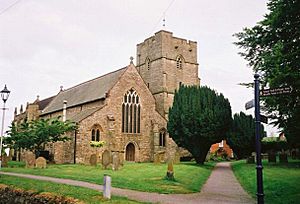St Andrew's Church, Presteigne facts for kids
Quick facts for kids St Andrew's Church |
|
|---|---|
 |
|
| Denomination | Church of England |
| Previous denomination | Roman Catholic |
| History | |
| Status | active |
| Architecture | |
| Heritage designation | Grade I |
| Designated | 1950 |
| Administration | |
| Parish | Presteigne with Discoed |
| Deanery | Kington and Weobley |
| Archdeaconry | Hereford |
| Diocese | Hereford |
| Province | Canterbury |
St Andrew's Church is a special old church in Presteigne, a town in Powys, Wales. It belongs to the Church of England. This church was first built a very long time ago, in the 800s, by people called the Anglo-Saxons. Even though it has been changed and fixed up many times since then, especially by the Normans and later in Victorian times, you can still see parts of the original Anglo-Saxon building. It's considered a very important historical building, known as a Grade I listed building.
Contents
History of St Andrew's Church
Early Beginnings: Anglo-Saxons and Normans
In the 9th century, the Anglo-Saxons built St Andrew's Church. It was located right next to the River Lugg. After the Norman conquest of Wales, much of the church was damaged. The Normans then rebuilt it, but they kept some parts of the old Anglo-Saxon church, like the north aisle.
Later, between the 12th and 13th centuries, the church became even bigger. A bell tower was added, and new sections like the nave and south aisle were built. These additions were made by religious leaders called canons from Wigmore Abbey.
Victorian Restoration and Important Memorials
From 1889 to 1891, the church underwent a big restoration. This work was led by a famous architect named John Loughborough Pearson. During this time, a special memorial was placed in the church's chapel. It honors Joseph Baker, a Royal Navy officer. A mountain in Washington state, USA, called Mount Baker, is named after him.
You can also find a 13th-century coffin lid inside the church. It's on the north side and might have belonged to a member of the powerful Mortimer Family. Because of its historical importance, St Andrew's Church was officially given Grade I listing in 1950.
The Ancient Tapestry
In 1737, St Andrew's Church received a very old and beautiful Flemish tapestry. This tapestry was made in 1510. It shows a famous scene from the Bible: Jesus' triumphal entry into Jerusalem.
When the church first got the tapestry, it was used as a cloth for the altar. This continued until the 1800s. Then, in the 19th century, it was framed and hung on the north wall of the church. This tapestry is very rare. It is one of only two tapestries from before the English Reformation that are still displayed in parish churches in the United Kingdom.
The 1915 Church Referendum
Why the Referendum Happened
In 1914, the British Parliament passed a law called the Welsh Church Act 1914. This law was meant to separate the Church in Wales from the Church of England. This process is called "disestablishment." It meant the Church in Wales would become independent.
However, the law's start was delayed. So, in 1915, seventeen parishes had a special vote, or referendum. These parishes, including Presteigne with Discoed, were unique. Their boundaries crossed the line between England and Wales.
St Andrew's Church's Decision
The people in these parishes got to choose. They could either stay part of the Church of England or join the new Church in Wales. Even though St Andrew's Church is located in Wales, its parishioners voted to remain with the Church of England. The vote was 595 people wanting to stay with the Church of England, and 289 wanting to join the Church in Wales.
Because of this vote, St Andrew's Church remained part of the Diocese of Hereford. This diocese is part of the Church of England, not the Church in Wales.

